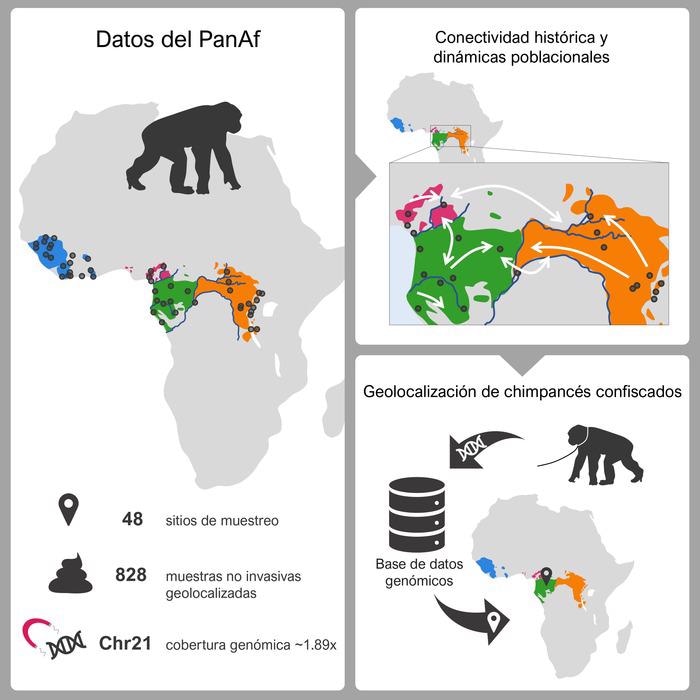Reviewed by Danielle Ellis, B.Sc.Jun 2 2022
Chimpanzees live in the savannahs and forests of tropical Africa. In contrast to the hominid sites that have been preserved to this day—mostly in caves and temperate climates—chimpanzee habitats have produced few specimens that have been preserved or discovered in the archaeological record. Due to the lack of chimp fossils, genetic data from contemporary populations is critical for defining their evolutionary history, genetic diversity, and contributing to their conservation.
 Graphic abstract of the study. Image Credit: Marina Álvarez-Estapé.
Graphic abstract of the study. Image Credit: Marina Álvarez-Estapé.
The Institute of Evolutionary Biology (IBE), a combined center of the CSIC and the Pompeu Fabra University (UPF) in Barcelona, the Max Planck Institute for Evolutionary Anthropology (MPI-EVA), and the German Centre for Integrative Biodiversity Research (iDiv) in Leipzig have created the most comprehensive catalog of genomic diversity in wild chimpanzee populations to date.
Hundreds of chimpanzee fecal samples were analyzed non-invasively utilizing innovative technology to extract genetic information. For the first time, techniques used to analyze ancient DNA in human populations have been utilized to extract genetic information from fecal samples from great apes.
Furthermore, the genetic database that researchers created has immediate uses for chimpanzee conservation, such as detecting illegal wildlife products and orphan trafficking pathways.
The first genomic atlas for chimpanzees with non-invasive samples
To develop the broadest and most thorough genetic diversity map of this African great ape, the researchers collected partial genome information from over 800 chimpanzee fecal samples.
Using methods designed to study ancient DNA, as in the case of Neanderthals, we have been able to retrieve genomic information from fecal samples, which are very difficult to work with. We have applied that approach to an unprecedented number of chimpanzee samples from the field.”
Tomàs Marquès-Bonet, Study Co-Author and Professor, Pompeu Fabra University
Marquès-Bonet is also the Principal Investigator of the Institute of Evolutionary Biology.
When various variables prohibit the collection of high-quality samples, such as blood or tissues, collecting geo-referenced non-invasive samples from nature is an excellent technique to get genetic information from wild chimpanzees.
We have seen that fecal samples, while imposing technical difficulties, provide very valuable genomic information for the study of wild chimpanzee populations, and also allow us the possibility to geo-reference them and track contacts between populations without affecting their well-being.”
Dr Clàudia Fontserè, Study First Author and Researcher, Institute of Evolutionary Biology, Comparative Genomics Group, Pompeu Fabra University
Reconstructing the evolutionary history of chimpanzees to promote their conservation
The scientists use this large data set to shed light on chimpanzees’ demographic history and give more evidence of genetic divergence and exchanges across the four recognized subspecies.
Geographic characteristics such as rivers, according to the study team, act as permeable barriers to gene flow not just between chimpanzee subspecies but also within groups. Researchers also postulated patterns of chimpanzee movement, connection, and isolation that have influenced the variance in the genetic landscapes of these populations over the past 100,000 years.
“We've noticed that sometimes, even though two communities are geographically very close, they may live on two different sides of a river and have only had very limited and sporadic contact. Our approach is very helpful in identifying barriers and natural corridors between populations and may have implications for their conservation.” Fontserè stated.
Chimpanzees, like humans, have had a complex evolutionary history. Their dynamics and areas of past and current population contact must be clearly identified in order to contribute to the protection of this endangered species.”
Dr Mimi Arandjelovic, Study Co-Lead Author and Researcher, Max Planck Institute for Evolutionary Anthropology, iDiv and Leipzig University
Dr Arandjelovic is the co-director of the Pan African Program: The Cultured Chimpanzee (PanAf), a group of researchers and conservationists from Africa, Europe, and North America who spent eight years gathering behavioral, ecological, and biological data from chimpanzees across the continent.
Genomics to fight chimpanzee illegal trafficking
The team has been able to consistently pinpoint where individuals originate thanks to the new genetic technology, which was previously impossible. The capacity to precisely define chimpanzee origins has obvious conservation implications, such as determining areas where poaching is likely to occur and identifying the routes and sources of illegal chimpanzee trafficking.
“The tool developed can infer the origin of the confiscated chimpanzees, usually at a few hundred kilometers from the real origin, and thus provide reliable information on the priority regions to be protected,” says Marquès-Bonet.
As part of a cooperation with the Illumina iConserve program, the established approach is already being used in worldwide conservation programs for the other great apes, bonobos, orangutans, and gorillas, and is presently being sequenced at the CNAG-CRG in Barcelona.
This research is part of the PanAf project, which is based in Leipzig’s Max Planck Institute for Evolutionary Anthropology and the German Centre for Integrative Biodiversity Research (iDiv), as well as Tomàs Marquès-European Bonet’s ERC Consolidator grant ApeGenomeDiversity.
Source:
Journal reference:
Fontserè, C., et al. (2022) Population dynamics and genetic connectivity in recent chimpanzee history. Cell Genomics. doi.org/10.1016/j.xgen.2022.100133.